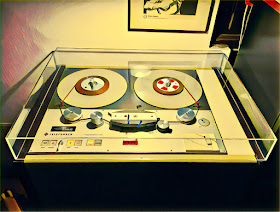Three motors, three speeds, four tracks, four heads, including Crossfield-technology head, sort of pre-magnetising record-tape-head.
This enhancing quality method only works on transparent Mylar tape formulation, not thick, not-mat back pro-tapes in recording-mode... no problem using other tapes in Playback.
This recorder was a teenager dream for yours truly, back in the '70s... it costed an arm and a leg.
I feel some
embarassment in saying how much I paid for it, thanking a friend's kindness.
Consider that this superb tape-machine remained in Tandberg's catalog in-parallel with TD-20A (which I also have in my collection, a sought-after two tracks-19/38 cm/s version), and it costed
exactly half the mighty 10 XD's price tag!
... not surprisingly, Tandberg 10 XD represents
the peak of reel-to-reel technology of the Norwegian brand... even more than the fabled, rare TD-20A-SE, soundwise.
A true Studer-killer, at least sonically...
So, here is a cool add for the smaller system, parallel to Gotorama - i.e. Fidelity Research AS-1, my all copper Partridges's 300B mono blocks, Tandberg 9220 XD 4 tracks-3,75/9,5/19 cm/s reel-to-reel and Tandberg 10 XD 2 tracks-9,4/19/38 cm/s, reel-to-reel, Merdidian CD 500 transports Mk1 and Mk2 and 564 DAC and Tandberg Typ !1 speakers on Foundation Designer speaker-stands.
A small, humbly great, no-frills audio system.
Love it.






































